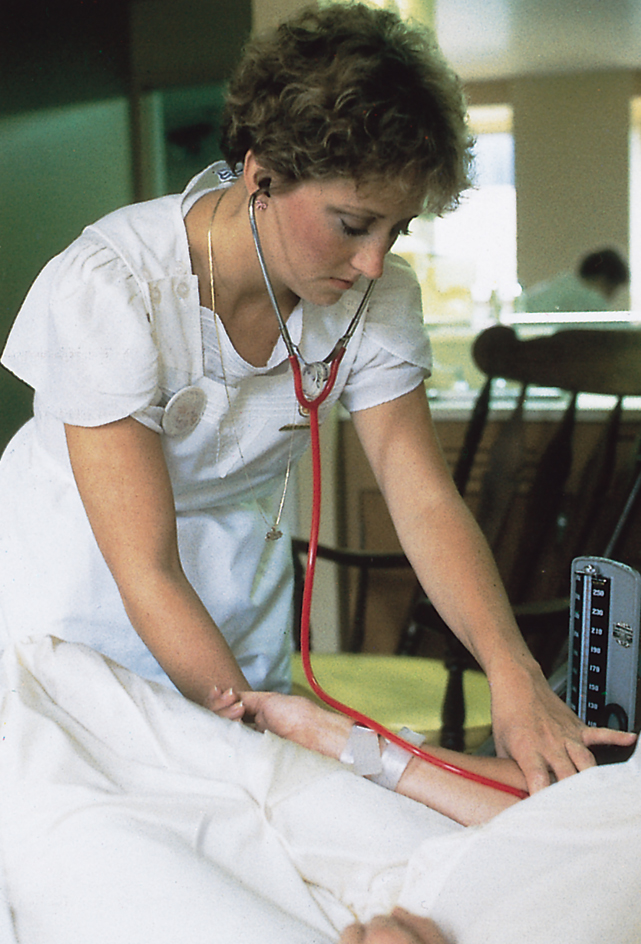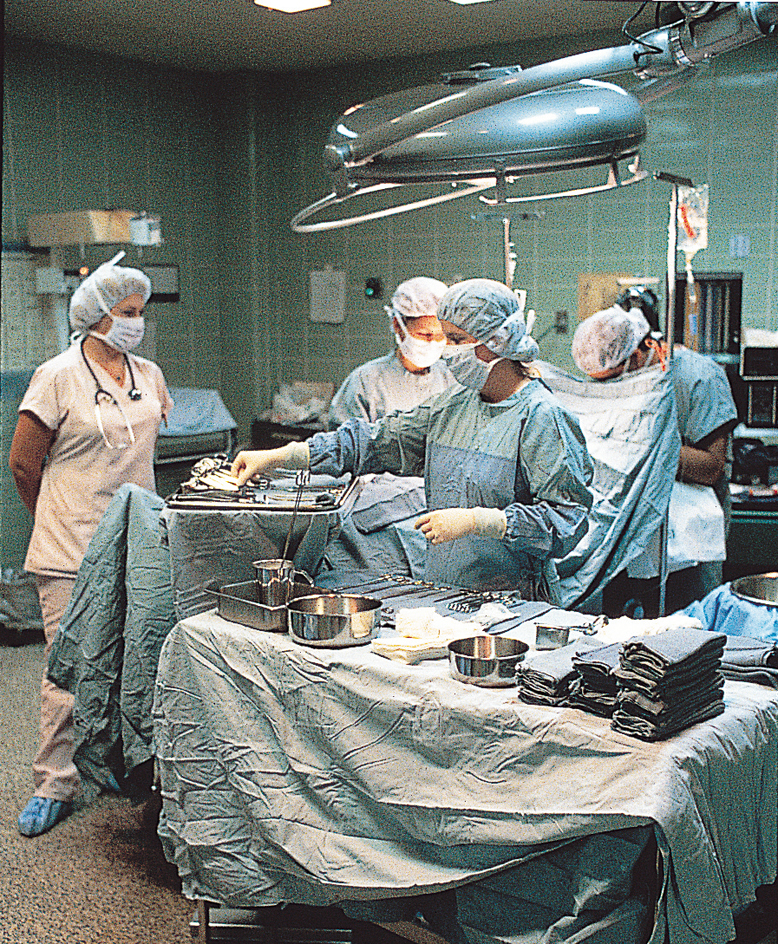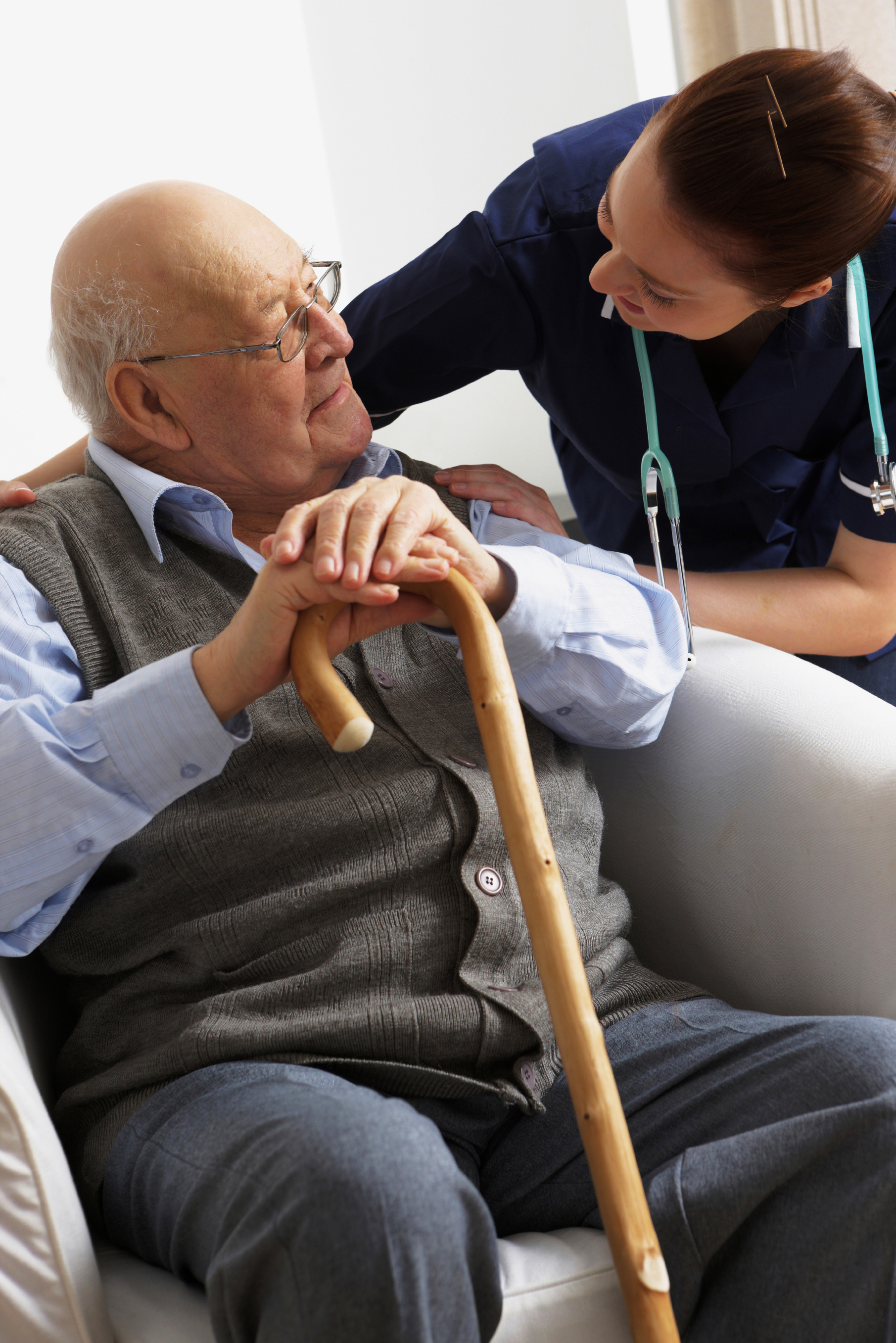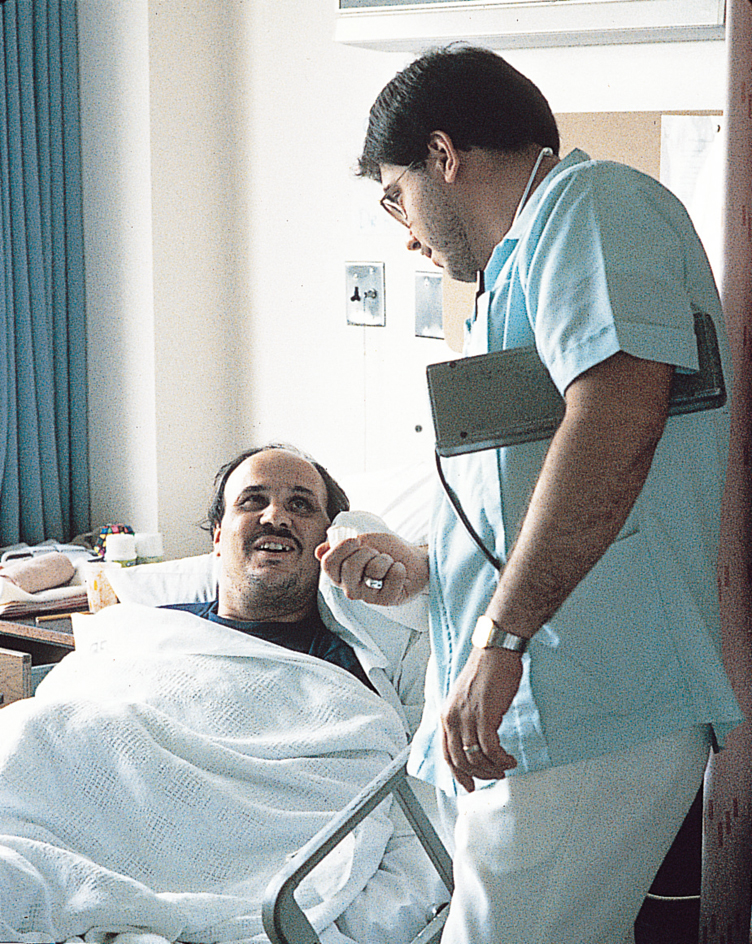Nursing is a profession that provides care to the sick, the injured, and other people in need of medical assistance. Nurses perform a wide variety of duties in many settings. Many nurses work in hospitals, outpatient clinics, or other health care facilities. Other nurses work in health insurance companies, research institutions, and pharmaceutical (medicinal drug) companies. Nurses also work in schools, in factories, and in the armed forces. Nurses may run general health screening or immunization clinics and blood drives.

Patients often get most of their direct health care through nurses. Among their duties, nurses record patient medical histories and symptoms, help perform medical tests, administer treatment and medications, operate medical machinery, and help with follow-up care and rehabilitation. They also provide advice and emotional support to patients and their families.
Nurses educate patients about various medical conditions. They teach patients and their families how to manage illnesses or injuries. They explain home care needs, including diet, nutrition, and exercise programs; physical therapy; and how to take medication. Some nurses work to promote public knowledge about health and health care. They may give public lectures on health and medical topics.
More women serve in the field of nursing than in any other profession except teaching. However, this trend is changing. Until the 1960’s, men made up only 1 percent of professional nurses. By the early 2000’s, men made up more than 10 percent of students enrolled in undergraduate professional nursing programs. Men make up about 6 percent of professional nurses.
Nursing careers
Nurses participate in every kind of health care, so there are a wide variety of career paths within nursing. In the United States, Canada, Australia, and many other countries, most nurses are registered nurses (RN’s). These nurses have graduated from an approved nursing education program. In the United States and some provinces of Canada, they have also passed a national licensing exam. Nurses with similar qualifications are called level one nurses in the United Kingdom.
Hospital nurses.
Most registered nurses work in hospitals. RN’s manage the daily care of patients, supervising nursing assistants. RN’s administer prescribed medicines to patients. They teach patients medication use and safety. An RN also educates patients on their illness and any necessary medical procedures.

The well-being of patients is of first importance to nurses. RN’s are taught to recognize and understand patients’ needs. They provide emotional support as well as physical care, taking time to reassure worried patients and boost their morale.
Each type of patient has special needs, requiring nurses with specialized knowledge or training. As a result, hospital nurses typically choose an area of specialization, just as most doctors develop a specialty. Nursing specializations range from basic primary care to fields requiring highly developed technical skills. Such specializations include surgical nursing, cardiovascular nursing (care of the heart and blood vessels), oncology nursing (cancer care), renal nursing (kidney care), orthopedic nursing (bone and muscle care), and neurological nursing (care of the nervous system). Nurses also specialize in radiology (the use of X rays to diagnose diseases and injuries) and anesthesiology (the administration of drugs for the relief of pain). Many of these technical specialties require additional certification by professional boards or associations.
RN’s in many other institutions perform in much the same way as hospital nurses. Such institutions include nursing homes and mental hospitals.
Licensed practical nurses
(LPN’s) work under the direct supervision of RN’s and doctors. In Texas and California, they are also called licensed vocational nurses (LVN’s). They may work in hospitals, private homes, nursing homes, public health agencies, and doctors’ offices. LPN’s perform many patient care tasks. These include measuring a patient’s temperature, blood pressure, pulse, weight, and other vital signs. LPN’s often care for mothers and babies, the aged, and people with chronic (long-lasting) illnesses. Frequently, they are responsible for such tasks as making beds, giving baths, and feeding those who cannot feed themselves. However, LPN’s cannot perform certain tasks that an RN can, such as administering prescription drugs or intravenous fluids, which are given into a vein.
Nurse managers
supervise the nurses in a unit or section of a hospital. The position of nurse manager usually requires an advanced degree in business or administration in addition to the requirements of nursing. In Australia and the United Kingdom, nurse managers are sometimes called nursing sisters.
Nurse practitioners
are nurses who have earned a master’s degree and received special advanced practice education. Some nurse practitioners specialize in geriatrics (caring for the aged). Others specialize in pediatrics (caring for children). Nurse practitioners perform many functions that were once done only by physicians. They can conduct physical examinations and diagnose and treat illness and injury. Nurse practitioners also advise and educate patients on health problems.

The role of nurse practitioner has grown to include working together with physicians. Depending on their specialties, nurse practitioners may work in hospitals. Many nurse practitioners operate private offices in partnership with a physician or independently.
Community health nursing.
Community health nurses usually help take care of large groups of people in their homes and communities. Those who wish to enter this field must take college courses approved for community health work.
Visiting nurses are community health or public health nurses who go into homes to care for patients. They may visit patients who have just returned from hospitals. They often teach patients with chronic illnesses, such as cancer and diabetes, how to care for themselves. They also teach patients and their families about proper diet, cleanliness, and other ways of preventing illness.
Community health nurses may take part in many community projects, such as immunization programs. Some of them work in schools and summer camps. Some work for the city or state. Others work for private hospitals that provide home health services to their patients.
Occupational and industrial health nursing.
Nurses work in factories, stores, banks, and many business offices. These nurses give first aid to the injured. They give employees physical examinations and screen employees for illnesses. They treat workers for colds, bruises, and other minor ailments. They also promote programs to prevent accidents on the job.
Private duty nurses,
unlike other nurses, are employed by the patient rather than by the hospital. Private duty nurses may devote all their time to only one patient who needs constant care. Sometimes, they care for a small group of patients. Most hospitals keep a registry, or file, of nurses who are available for private duty.
Other nursing careers.
Many professional nurses combine the professions of teaching and nursing. To teach in a school of nursing, a professional nurse must have advanced college preparation. A doctoral degree in nursing is usually required. Many nurses work as nurse researchers. They can conduct research on a variety of topics. Examples include how to relieve patient suffering and how to decrease vomiting in patients undergoing chemotherapy (treatment with drugs). A nurse researcher might also study injuries in the workplace, identifying possible causes and developing ergonomic tools, designed to reduce or eliminate injuries.
Some nurses hold positions in nursing organizations. Others write books and articles about nursing. Companies that manufacture drugs and medical equipment often employ nurses as consultants on their products. Nurses serve in the armed forces. Other branches of the government also have nurses on their staffs.
Planning a nursing career
Nursing offers satisfaction to those who desire to help others. It also provides a wide range of job opportunities. A capable nurse—especially one with an advanced degree—can generally feel sure of a job. Salaries for nurses are often high compared with those for other professions.

People considering a career in nursing should consider a number of additional factors. Hospital nurses must be active and remain on their feet a great deal. They may have to do strenuous work, such as lifting patients. Special body mechanics courses taught in nursing schools help the nurse prepare for such activities.
A nurse must like people and want to help them. A nurse must also have self-reliance and good judgment. Patience, tact, honesty, responsibility, and the ability to work easily with others are valuable traits. Good health is another requirement.
Most nursing schools accept only candidates who rank in the upper half or upper third of their high school graduating classes. Entrance requirements for licensed practical nursing are less exacting. High school graduates are preferred. But many LPN training programs accept candidates who have passed high school equivalency exams if they have not completed high school.
Professional nursing education.
Three types of programs provide the necessary training for a career in professional nursing. They are associate degree programs, diploma programs, and baccalaureate programs.
Associate degree programs consist of a two-year course of study in nursing care and related subjects. These programs lead to an associate degree in nursing. Many junior and community colleges offer such programs. Students also gain practical experience by working in hospitals and other health agencies that cooperate in the programs.
Diploma programs are offered by hospital schools. They require two or three years of study, after which the student receives a diploma. Students take nursing courses in classrooms and laboratories. They work with patients in the hospital and at health agencies.
Baccalaureate programs offered by colleges and universities lead to a bachelor of science degree. The course work requires four to five years. It includes experience with patients in hospitals and health agencies as well as courses in nursing and in the humanities.
All nursing education programs provide both classroom training and practical experience. They prepare the student for obtaining a license to practice as a registered nurse.
Classroom work.
Nursing students study such subjects as anatomy, chemistry, nutrition, pharmacology (the study of the effects of drugs on living things), physiology (the study of body functions), psychology, and sociology (the study of human society). They also learn the fundamentals of nursing care. They learn to care for the sick by working in the nursing laboratory. Frequently, the students practice on one another. For example, one student may take another’s temperature, blood pressure, and pulse rate.
Clinical experience.
All schools of nursing integrate classroom work or theory with practice. Clinical experience, or practice, means the time that the student spends in learning to care for patients. As part of their clinical experience, students also learn about hospital routine and the functions of various departments.
Nursing students have experience with all types of patients. A teacher who is an expert nurse supervises all their early activities. As students gain experience and knowledge, they work more independently.
Licensing.
The requirements for a license to practice nursing vary from country to country. In most countries, including Australia and the United Kingdom, a nurse must have graduated from a university’s nursing program or from an approved school of nursing. In some countries, including the United States, India, South Africa, and some Canadian provinces, nurses must also pass a written examination after graduation. The nurse then receives a license to practice in the state or province. She or he is now a registered nurse.
Nurses may advance their careers by additional study and experience. A master’s degree is often the step to specialization, teaching, or administration. To advance further, a nurse may earn a doctoral degree as preparation for teaching and conducting research.
Practical nursing courses
usually last one year. Like professional nursing education, practical nursing courses combine classroom study with actual experience.
There are two types of schools of practical nursing, public and private. Some public schools teach practical nursing as part of their vocational-training or adult-education programs. Hospitals, health agencies, and some junior colleges and universities operate private schools of practical nursing.
Credits for courses taken at vocational nursing schools often cannot be directly transferred to professional nursing schools. However, some nursing school programs allow vocational nurses to obtain a degree without repeating basic courses.
In all the states, and in some Canadian provinces, a practical nurse, like a professional nurse, must obtain a license to practice. He or she then becomes a licensed practical nurse or licensed vocational nurse. Nurses with similar qualifications are called enrolled nurses in Australia and New Zealand and level two nurses in the United Kingdom.
Career information.
A high school student who wants to learn about a nursing career should talk with a vocational guidance counselor, school nurse, or other nurses. Many high schools have “future nurses” clubs whose members visit hospitals and schools of nursing and do volunteer work. Serving as a nurse’s aide or as an orderly in a hospital is another way to learn more about nursing (see Nurse’s aide ).
History
Some form of nursing care has probably been practiced for thousands of years. For example, the early Israelites and Egyptians hired women, later called midwives, who assisted at births.
Modern nursing traces its roots to early Christian times. It was then that nurses first organized into groups. Noblewomen, including the wives of the emperors, helped care for the ill in ancient Rome. During the Crusades, a series of religious wars waged by Christians against Muslims from 1096 to the 1500’s, military nursing orders of monks and knights tended the sick and wounded.
Many monasteries closed during the Reformation, a religious movement of the 1500’s that led to Protestantism. There were only a few places where religious orders could nurse the sick. The years from 1600 to 1850 were the darkest period in the history of nursing. Hospitals often were built as charity hospitals. They were usually staffed by untrained, sometimes disreputable, women. Wealthy people never went to hospitals. The importance of sanitation and hygiene was unknown. People did not understand how diseases spread. Nurses who took care of patients with contagious diseases often contracted these diseases themselves.
Nursing as we know it began in the 1850’s with the work of the English nurse Florence Nightingale. Nightingale was the founder of modern professional nursing. She established the first school of nursing, the Nightingale Training School for Nurses, in London in 1860. Graduates of this school traveled to all parts of the world to teach nursing.

The first nursing schools in the United States were established in 1873 at Massachusetts General Hospital in Boston, Bellevue Hospital in New York City, and the New Haven (Connecticut) Hospital. The American Nurses Association, Inc., an organization of registered nurses, was organized in 1896.
Many nurses have won world fame. They include Clara Barton, Edith Cavell, Elizabeth Kenny, and Lillian D. Wald.
